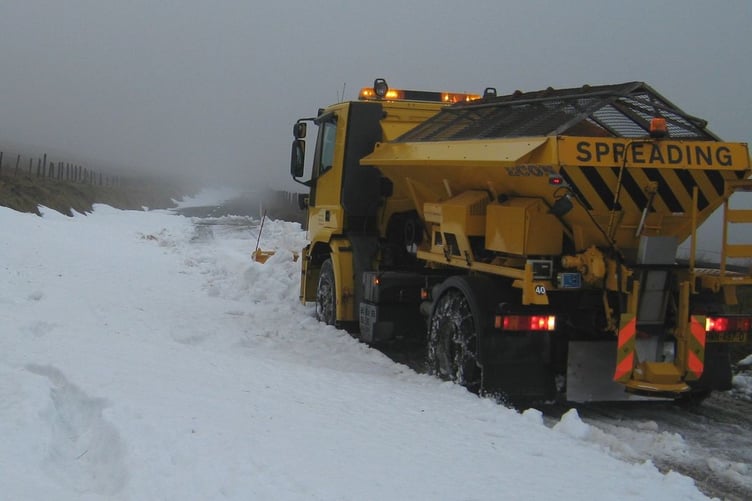The Department of Infrastructure has provided the public with answers to the questions its staff are asked when the weather turns cold.
Snow is forecast tomorrow. Click here.
What is road grit?
The most common material used to treat road surfaces prior to ice formation is rock salt. Rock salt is a brown colour because it is unrefined and contains impurities, so it is often referred to as grit. Our salt is also combined with molasses, an agricultural by-product. This material is more expensive, but improves adhesion as it is slightly heavier so that more of the salt mixture ends up on the road surface rather than spraying onto verges.
Where does the island's road grit come from?
Salt is mined by the Irish Salt Mining & Exploration Co Ltd, Kilroot. The island maintains a holding stock of around 12,000 tonnes stored at three strategic locations — Ellerslie, Glen Duff and Balthane.
How does gritting work?
Rock salt lowers the freezing point of moisture on the road surface, stopping ice from forming and causing existing ice or snow to melt.
The roads are white — why haven't you gritted?
Grit is meant to stop ice forming on the road surface.
Grit will generally not stop snow lying on roads, unless the snowfall is very light indeed.
When snow falls it will generally lie on roads and we need to plough and then grit again to clear it. Grit also relies on the mechanical action of tyres to make it work well. That is why in snow conditions the tyre tracks turn black while much of the rest of the road remains white. If traffic is light roads will take longer to turn black.
My road is supposed to have been gritted — why is it still icy?
Even when a road has been gritted, ice can still form. For example, a shower of rain after we have gritted can wash the salt off the road surface and it can then freeze; or water seepage from land may cause water to run across the road and wash salt off. For these reasons, great care is always needed in sub-zero conditions.
Can it get too cold for grit to work?
Yes. Salt will work at temperatures down to minus 8-10 degrees Celsius. However, the salt becomes less effective below minus 6 degrees C and the road can still freeze.
How is the treatment of the network prioritised?
The main gritting routes, which can be found online at gov.im/gritting, are treated first and cover the links between high levels of population. The next priority is bus routes and areas surrounding hospitals, schools and residential homes. Once these routes are cleared, the department will clear snow in residential estates.
When is gritting carried out?
This depends on a variety of factors. When we receive a weather forecast that indicates roads may require gritting, where possible we carry out the gritting treatment in the evening at approximately 6pm and / or 5am prior to morning commuting traffic building up on the roads. Gritting at this time ensures the best performance of the grit. Spreading salt at these times also means the roads are treated in advance of peak traffic flows, before the times where frost and ice will form, and when there will be enough traffic on the roads to help the salt mix with the moisture to form a saline solution.
Where the weather forecast cannot confirm with certainty that a treatment will be needed, we will continuously monitor the weather data and order a grit treatment only if it is needed or where reports of icy conditions dictate.
Gritting cannot be carried out when it is raining or it is forecast to rain as the rain washes the grit off the road. High winds also pose a problem and will blow the grit away, so monitoring the weather conditions is critical in informing the right time to deploy the gritters.
How much grit is used?
For pre-gritting we use approximately 10g/m2 which is sufficient to ensure the salinity of the moisture in the road prevents ice forming. During snow fall events this may be increased to 20-40g/m2, however this is assessed on how much salt has already been applied.
Is too much grit a problem?
Continual application of grit can be equally as problematic as insufficient gritting. Too much salt causes a brine build up, which will also cause the roads to become slippery. Additionally, wildlife and vegetation are affected by the excessive salt levels in run-off from the highway.
Does the department treat footways?
The department will endeavour to clear footway links to schools etc. This is, however, subject to availability of resources and other priorities at the time.
How can the public help themselves?
There are more than 900 salt bins across the network — to find your nearest salt bin visit gov.im/maps, then select Island Infrastructure and then salt bins. Each bin has a unique reference number and you can request it to be refilled by calling the department on 672000. Salt is also available at the four local amenity sites and can be collected free of charge.
I have already asked for a salt bin but you haven't delivered it?
We are working to keep existing bins refilled and act on requests for new bins providing they meet our assessment criteria.
Is salt sold for commercial use?
Yes. Salt is sold for commercial use to enable companies to function during severe weather events, and therefore its sale is limited as it is not intended for onward sale.
How many gritters does the department have?
The department have six frontline gritters 2x9m3 (11 tonne) and 4x6m3 (7.5 tonne) carrying capacity along with two small demountable gritting units.
Can anyone drive a gritter?
No. All our staff are fully trained to the industry standard for winter service delivery with training and assessment through the City & Guilds 6159 qualification.
Who makes the decision to grit?
The decision is made by a senior officer within highway services for planned gritting, and our duty officer will make this decision (out of hours) for reactive gritting. The decision is based on the information contained within a weather warning issued by the duty forecaster at the Met Office at Ronaldsway Airport, along with our officer’s local knowledge and experience.
See the Met Office's site here.



-(2).jpeg?width=209&height=140&crop=209:145,smart&quality=75)

Comments
This article has no comments yet. Be the first to leave a comment.